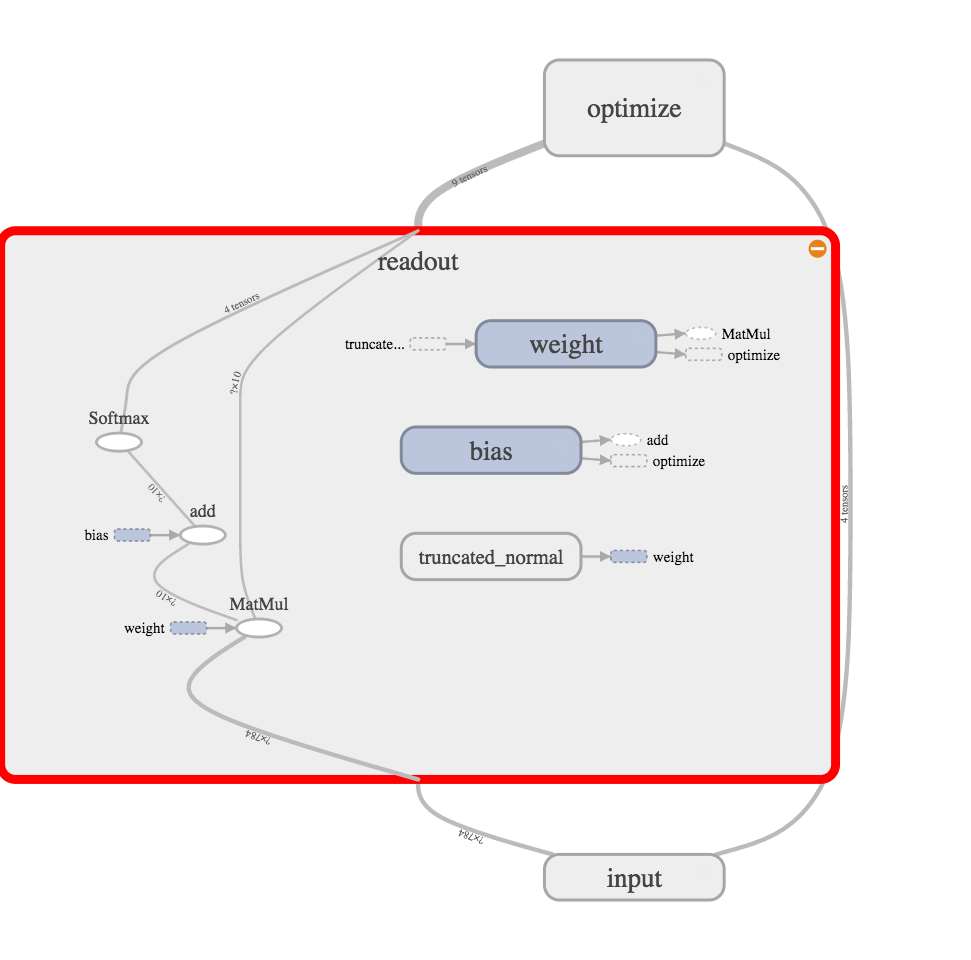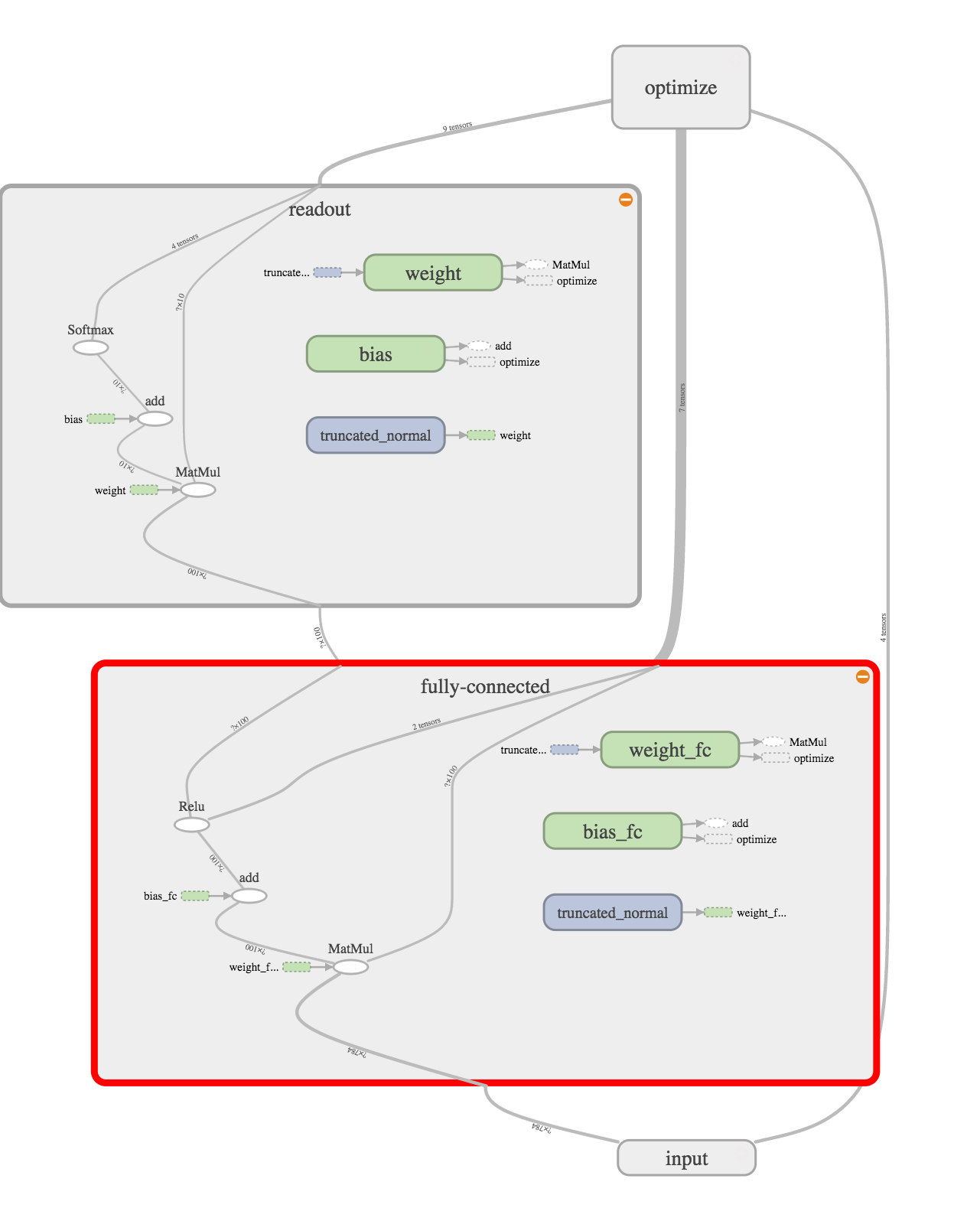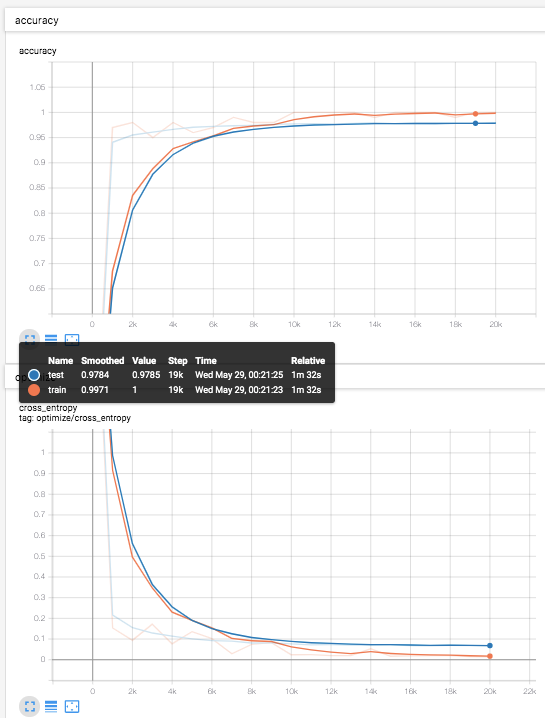(目次はこちら)
(Tensorflow 2.0版: https://qiita.com/kumonkumon/items/337796dae8d42ce36fa8)
はじめに
前回の記事 では、多項ロジスティック回帰について扱った。これは、 TensorFlowのTutorialのMNIST For ML Beginners ほぼそのままなので全く面白くないので少し拡張してみる。(追記: MNIST For ML Beginnersは2019年時点ではもうありません)
This should be about 91%.
Is that good? Well, not really. In fact, it's pretty bad. This is because we're using a very simple model. With some small changes, we can get to 97%
「多項ロジスティック回帰では、91%くらいの精度で、いい結果じゃないよ、少し変えれば97%くらいいくよ。」と。
ただ、この、
With some small changes
がなんなのかは書いていないので、ちょっと何か試してみる。
多層パーセプトロン(multilayer perceptron)
多項ロジスティック回帰を、多層パーセプトロンへと拡張してみる。
画像に限らず、何かのデータを識別するときには、「入力データから特徴抽出して識別器にかける」というのが王道。
前回の記事 では、入力データを直接識別器にかけて認識していたので、入力データそのもの、すなわち、画像の画素値そのものが特徴として扱われていたことになる。
今回は、特徴抽出部分を追加してみる。特徴抽出といってもやり方はいろいろあって、
- エッジ抽出フィルタ
- SIFT
- SURF
- etc...
などなど、、でも、ここでは、画像にとらわれない特徴抽出的な層を一つ追加することにする。「特徴抽出的な層」っと言ってもなんのことやらだけど、多項ロジスティック回帰の中に、「特徴抽出的な層」としてロジスティック回帰をねじ込んでみる。
前回の記事 での、多項ロジスティック回帰はこんな感じ。

readout layerとinput layerの間に、fully-conneced layer(全結合層)というのがねじ込まれている。で、よく見てみると、入力を線形変換してReLU(ランプ関数)という活性化関数にかけて、その結果をreadout layerに入れていることがわかる。
これは、活性化関数にステップ関数を使っていないのでパーセプトロンではないけど、多層パーセプトロン(multilayer perceptron)とよばれているもの。ここまでくるとニューラルネットワークっぽくなった。
コード
Python: 3.6.8, Tensorflow: 1.13.1で動作確認済み
(もともと2016年前半に書いたものなので、順次更新しています。)
from helper import *
IMAGE_SIZE = 28 * 28
CATEGORY_NUM = 10
LEARNING_RATE = 0.1
FEATURE_DIM = 100
TRAINING_LOOP = 20000
BATCH_SIZE = 100
SUMMARY_DIR = 'log_softmax_fc'
SUMMARY_INTERVAL = 1000
BUFFER_SIZE = 1000
EPS = 1e-10
with tf.Graph().as_default():
(X_train, y_train), (X_test, y_test) = mnist_samples(flatten_image=True)
ds = tf.data.Dataset.from_tensor_slices((X_train, y_train))
ds = ds.shuffle(BUFFER_SIZE).batch(BATCH_SIZE).repeat(int(TRAINING_LOOP * BATCH_SIZE / X_train.shape[0]) + 1)
next_batch = ds.make_one_shot_iterator().get_next()
with tf.name_scope('input'):
y_ = tf.placeholder(tf.float32, [None, CATEGORY_NUM], name='labels')
x = tf.placeholder(tf.float32, [None, IMAGE_SIZE], name='input_images')
with tf.name_scope('fully-connected'):
W_fc = weight_variable([IMAGE_SIZE, FEATURE_DIM], name='weight_fc')
b_fc = bias_variable([FEATURE_DIM], name='bias_fc')
h_fc = tf.nn.relu(tf.matmul(x, W_fc) + b_fc)
with tf.name_scope('readout'):
W = weight_variable([FEATURE_DIM, CATEGORY_NUM], name='weight')
b = bias_variable([CATEGORY_NUM], name='bias')
y = tf.nn.softmax(tf.matmul(h_fc, W) + b)
with tf.name_scope('optimize'):
y = tf.clip_by_value(y, EPS, 1.0)
cross_entropy = -tf.reduce_mean(tf.reduce_sum(y_ * tf.log(y), axis=1))
train_step = tf.train.GradientDescentOptimizer(LEARNING_RATE).minimize(cross_entropy)
cross_entropy_summary = tf.summary.scalar('cross entropy', cross_entropy)
with tf.Session() as sess:
train_writer = tf.summary.FileWriter(SUMMARY_DIR + '/train', sess.graph)
test_writer = tf.summary.FileWriter(SUMMARY_DIR + '/test')
correct_prediction = tf.equal(tf.argmax(y, 1), tf.argmax(y_, 1))
accuracy = tf.reduce_mean(tf.cast(correct_prediction, tf.float32))
accuracy_summary = tf.summary.scalar('accuracy', accuracy)
sess.run(tf.global_variables_initializer())
for i in range(TRAINING_LOOP + 1):
images, labels = sess.run(next_batch)
sess.run(train_step, {x: images, y_: labels})
if i % SUMMARY_INTERVAL == 0:
train_acc, summary = sess.run(
[accuracy, tf.summary.merge([cross_entropy_summary, accuracy_summary])],
{x: images, y_: labels})
train_writer.add_summary(summary, i)
test_acc, summary = sess.run(
[accuracy, tf.summary.merge([cross_entropy_summary, accuracy_summary])],
{x: X_test, y_: y_test})
test_writer.add_summary(summary, i)
print(f'step: {i}, train-acc: {train_acc}, test-acc: {test_acc}')
コードの説明
多項ロジスティック回帰と異なる部分を。
全結合層
追加された層。入力データを線形変換してReLUという活性化関数を通っている。FEATURE_DIMは出力を何次元にするか(何次元の特徴ベクトルにするか)のパラメータ。
with tf.name_scope('fully-connected'):
W_fc = weight_variable([IMAGE_SIZE, FEATURE_DIM], name='weight_fc')
b_fc = bias_variable([FEATURE_DIM], name='bias_fc')
h_fc = tf.nn.relu(tf.matmul(x, W_fc) + b_fc)
出力層
入力が全結合層の出力となるように変更。
with tf.name_scope('readout'):
W = weight_variable([FEATURE_DIM, CATEGORY_NUM], name='weight')
b = bias_variable([CATEGORY_NUM], name='bias')
y = tf.nn.softmax(tf.matmul(h_fc, W) + b)
以上です。変更量は非常に少ない。
結果
テストデータ(青線)での識別率は、97.8%程度。
前回の記事 での、多項ロジスティック回帰での結果が、92.4%程度だったのでかなり改善している。
あとがき
今回は、多項ロジスティック回帰を拡張して、多層パーセプトロンにしてみました。次回の記事では、畳み込みニューラルネットワーク(Convolutional Neural Network:CNN)に足を踏み入れてみます。

